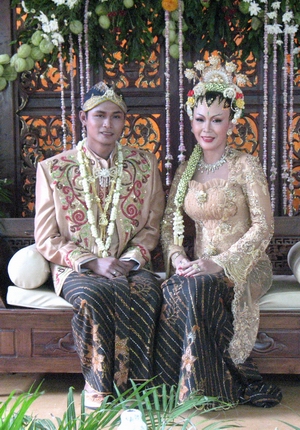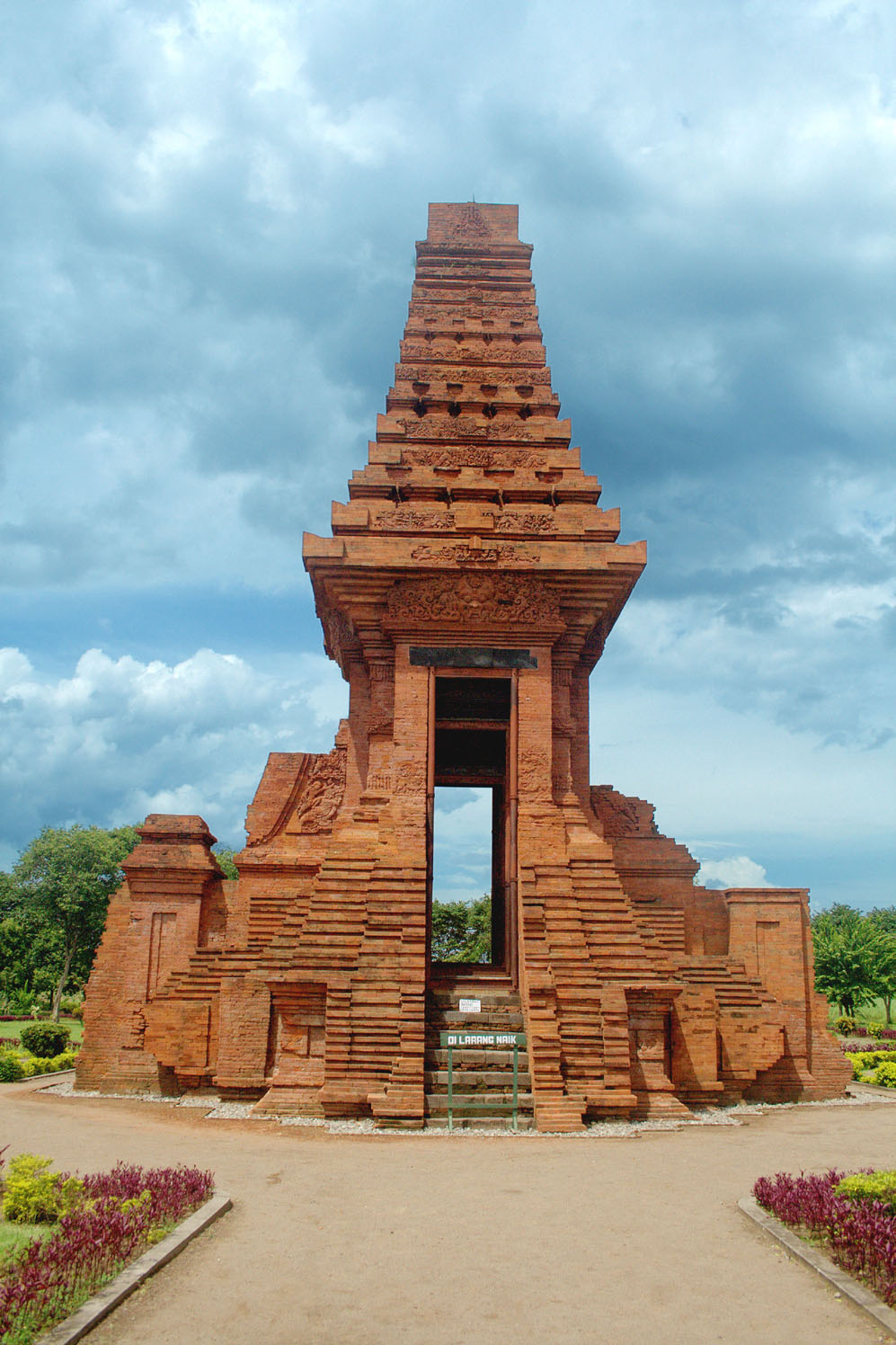|
Pamalayu Expedition
The Pamalayu campaign was a diplomatic and military expeditionary force sent by the Javanese King Kertanegara of Singhasari to conquer the Sumatran Melayu Kingdom. It was decreed in 1275, though perhaps not undertaken until later. Little is known about the results of the expedition. The Padang Roco Inscription dated from 1286 states that a religious statue of Amoghapasa was established at Dharmasraya on the orders of Kertanagara, and that all the inhabitants of Melayu and especially their king, Tribhuwanaraja rejoiced at the presentation of the gifts. History The expedition arguably established Javanese domination over Melayu and trade in the Strait of Malacca. To cement the relationship between the two kingdoms, a political marriage was arranged. According to the Pararaton, two Malay princesses, Dara Petak and Dara Jingga, went to Java, originally intended for Kertanegara. However following his demise by Jayakatwang, princess Dara Petak would later be married to Kertanegara ... [...More Info...] [...Related Items...] OR: [Wikipedia] [Google] [Baidu] [Amazon] |
Javanese People
The Javanese ( , ; ) are an Austronesian peoples, Austronesian ethnic group native to the central and eastern part of the Indonesian island of Java. With more than 100 million people, Javanese people are the largest ethnic group in both Indonesia and in Southeast Asia as a whole. Their native language is Javanese language, Javanese, it is the largest of the Austronesian languages in List of languages by number of native speakers, number of native speakers and also the largest regional language in Southeast Asia. As the largest ethnic group in the region, the Javanese have historically dominated the social, political, and cultural landscape of both Indonesia and Southeast Asia. There are significant numbers of Javanese diaspora outside of Central Java, central and East Java, eastern Java regions, including the other provinces of Indonesia, as well as other countries such as Suriname, Singapore, Malaysia, Egypt, Saudi Arabia, South Africa, Sri Lanka, Yemen and the Netherlands. ... [...More Info...] [...Related Items...] OR: [Wikipedia] [Google] [Baidu] [Amazon] |
Dara Jingga
Dara Jingga, was one of the ethnic Malay, Malay Dharmasraya princess who was intended to be betrothed to Javanese King Kertanegara of Singasari after the Pamalayu expedition 1275–1293. Dara Jingga was the older sister of Dara Petak, the consort of Raden Wijaya, Kertarajasa Jayawardhana, King of Majapahit. She married Adwayawarman, Adwayabrahma (''Rakryan Mahamantri''), and the mother of Adityawarman, later become the king of her native kingdom Dharmasraya in Sumatra. The name ''Dara Jingga'' in old Malay means "scarlet dove". Early life Dara Jingga was the daughter of King Tribhuwanaraja, Srimat Tribhuwanaraja Mauliawarmadewa of the Dharmasraya Kingdom in Sumatra, and, along with her sister, was taken to Java to wed the Singhasari King. The Dharmasraya kingdom may have had an alliance with Singhasari in order to face the Mongol invasion. According to ''Pararaton'', ten days after the expulsion of Mongol invasion of Java, Mongol forces from Java, the Pamalayu expedition led by ... [...More Info...] [...Related Items...] OR: [Wikipedia] [Google] [Baidu] [Amazon] |
Military History Of Indonesia
The military history of Indonesia includes the military history of the modern nation of Republic of Indonesia, as well as the military history of the states which preceded and formed it. It encompassed a kaleidoscope of conflicts spanning over a millennia. The ancient and medieval part of it began as tribal warfare began among Native Indonesian, indigenous populations, and escalated as kingdoms emerged. The modern part is defined by foreign colonial occupations, battles for independence through guerrilla warfare during Indonesian National Revolution, regional conquests and disputes with neighbouring countries, as well as battles between the Republic and separatist factions. Since the formation of the Republic, the Indonesian military, military has played significant role in state affairs. However, in Post-Suharto era, the Indonesian military has retreated from politics, yet it still possesses some influences. As an Indonesian archipelago, archipelagic nation, historically Indon ... [...More Info...] [...Related Items...] OR: [Wikipedia] [Google] [Baidu] [Amazon] |
Borneo
Borneo () is the List of islands by area, third-largest island in the world, with an area of , and population of 23,053,723 (2020 national censuses). Situated at the geographic centre of Maritime Southeast Asia, it is one of the Greater Sunda Islands, located north of Java Island, Java, west of Sulawesi, and east of Sumatra. The island is crossed by the equator, which divides it roughly in half. The list of divided islands, island is politically divided among three states. The sovereign state of Brunei in the north makes up 1% of the territory. Approximately 73% of Borneo is Indonesian territory, and in the north, the East Malaysian states of Sabah and Sarawak make up about 26% of the island. The Malaysian federal territory of Labuan is situated on a small island just off the coast of Borneo. Etymology When the sixteenth-century Portuguese explorer Jorge de Menezes made contact with the indigenous people of Borneo, they referred to their island as ''Pulu K'lemantang'', which ... [...More Info...] [...Related Items...] OR: [Wikipedia] [Google] [Baidu] [Amazon] |
Simalungun People
The Simalungun (also known as Simalungun Batak) people are an ethnic group in North Sumatra, considered one of the Batak (Indonesia), Batak peoples. Simalungun people live mostly in Simalungun Regency and the surrounding areas, including the city of Pematang Siantar, an autonomous city, but previously part of Simalungun Regency. The Simalungun live in the 'Eastern Batak' lands, bordering the lands of the Toba Batak people, Batak Toba to the south and west, and the Karo (people), Karo Batak to the north. Simalungun is linguistically closely related to Toba Batak, but culturally closest to Karo Batak. Both Batak groups migrated from Toba and Pakpak to participate in trade. The Simalungun language is still spoken by many Simalungun people, in addition to Toba Batak language, Toba Batak and Indonesian. Traditional Simalungun life Long before Dutch colonialism was established in North-East Sumatra, people now known collectively as Batak Timur (Eastern Batak) claimed the area as the ... [...More Info...] [...Related Items...] OR: [Wikipedia] [Google] [Baidu] [Amazon] |
Adityawarman
Adityawarman (formal regnal name Maharajadiraja Srīmat Srī Udayādityawarma Pratāpaparākrama Rājendra Maulimāli Warmadewa. ) was a king of Malayapura Suvarnabhumi, and is the successor of the Mauli dynasty based in central Sumatra. He was the cousin of Jayanegara, king of Majapahit from 1309 to 1328, and the grandson of Tribhuwanaraja, king of Melayu Kingdom. Adityawarman was awarded the Senior Minister of Majapahit (''wreddamantri'') and used this authority to launch Majapahit military expansion plans and conquer east coast region in Sumatra. Adityawarman then founded the royal dynasty of Minangkabau in Pagaruyung and presided over the central Sumatra region to take control of the gold trade between 1347 and 1375. Early life Adityawarman was born around in 1294 in Trowulan, East Java, the capital of the kingdom of Majapahit, as recorded in the poem of Pararaton. According to Kuburajo inscription found in Limo Kaum, West Sumatra, Adityawarman's father was ... [...More Info...] [...Related Items...] OR: [Wikipedia] [Google] [Baidu] [Amazon] |
Adwayawarman
Adwayawarman was the father of King Adityawarman of Malayapura kingdom (now in West Sumatra province, Indonesia) as mentioned in the Kuburajo inscription, Kuburajo I Inscription. His alias name was Adwayadwaja, as he was called in the Bukit Gombak Inscription. Historian Slamet Muljana suspected that Adwayawarman was also the same person as Adwayabrahma, who was mentioned in the Padang Roco Inscription. Adwayabrahma was the name of one of the Javanese high officials (''Rakryan Mahamantri'') of the Singhasari kingdom, who was sent to transport the statue of Amoghapasha to the Dharmasraya kingdom. If this notion is right, Adityawarman was a king of Malayo-Javanese mixed blood. It was told in the Javanese chronicle Pararaton (''Book of Kings'') that Dara Jingga, one of the Malay princesses who was brought back to Java with the Pamalayu expedition, was married to a Javanese nobleman (''alaki Dewa''). His son was called ''Tuhan Janaka'' or ''Sri Marmadewa'', who finally reigned in Sumatra ... [...More Info...] [...Related Items...] OR: [Wikipedia] [Google] [Baidu] [Amazon] |
Landak Regency
Landak Regency is a regency of West Kalimantan province, Indonesia. It was created on 4 October 1999 from the northeastern part of Pontianak Regency. It covers 9,909.10 km2 and had a population of 329,649 at the 2010 CensusBiro Pusat Statistik, Jakarta, 2011. and 397,610 at the 2020 Census;Badan Pusat Statistik, Jakarta, 2021. the official estimate as at mid 2024 was 419,092 (comprising 218,953 males and 200,139 females).Badan Pusat Statistik, Jakarta, 28 February 2025, ''Kabupaten Landak Dalam Angka 2025'' (Katalog-BPS 1102001.6103) The principal town lies at Ngabang. Landak is also one of the four regencies in West Kalimantan whose population is predominantly Catholic, the others being Sanggau, Sekadau, and Sintang. Administrative districts Landak Regency consists of thirteen districts (''kecamatan''), tabulated below with their areas and their populations at the 2010 CensusBiro Pusat Statistik, Jakarta, 2011. and the 2020 Census,Badan Pusat Statistik, Jakarta, 20 ... [...More Info...] [...Related Items...] OR: [Wikipedia] [Google] [Baidu] [Amazon] |
Batak
Batak is a collective term used to identify a number of closely related Austronesian peoples, Austronesian ethnic groups predominantly found in North Sumatra, Indonesia, who speak Batak languages. The term is used to include the Karo people (Indonesia), Karo, Pakpak people, Pakpak, Simalungun people, Simalungun, Batak Toba people, Toba, Angkola people, Angkola, Mandailing people, Mandailing and related ethnic groups with distinct languages and traditional customs (''adat''). History Prehistory While the archaeology of southern Sumatra testifies to the existence of Neolithic settlers, it seems that the northern part of Sumatra was settled by agriculturalists at a considerably later stage. Although the Batak are often considered to be isolated peoples due to their location inland, away from the influence of seafaring European colonials, there is evidence that they have been involved in trade with neighbouring kingdoms for a millennium or more. Influenced by Tamil Peoples Th ... [...More Info...] [...Related Items...] OR: [Wikipedia] [Google] [Baidu] [Amazon] |
Jayanegara
Jayanegara or Jayanagara (formal regnal name Sri Maharaja Wiralandagopala Sri Sundarapandya Dewa Adhiswara or Sri Sundarapandyadevadhisvara Vikramottungadeva, also known as Kala Gemet) was a Javanese emperor and the second monarch of the Majapahit Empire from 1309 to his death in 1328, and also Prince of Kediri from 1295. Jayanegara was the heir, crown prince, and only son of Raden Wijaya, the founder of Majapahit. The story of his life was written in several records, including the ''Pararaton'' and ''Negarakertagama''. His reign saw the beginning of Gajah Mada's rise to influence in the empire. Early life Dyah Wijaya took all of Kertanegara's four daughters' hands in marriage. The sisters were ''Parameswari'' Tribhuwana also known as Trubhuwaneswari (the eldest), Prajnaparamita, Narendraduhita, and ''Rajapatni'' Gayatri (the youngest). The reason for Dyah Wijaya's practice of sibling polygamy was to ensure his claim of legitimacy and to prevent the contest for Kertanegara's S ... [...More Info...] [...Related Items...] OR: [Wikipedia] [Google] [Baidu] [Amazon] |
Raden Wijaya
Raden Wijaya or Raden Vijaya, also known as Nararya Sangramawijaya and his regnal name Kertarajasa Jayawardhana was a Javanese emperor and founder of the Majapahit Empire who ruled from 1293 until his death in 1309.Slamet Muljana, 2005, ''Runtuhnya Kerajaan Hindu-Jawa dan Timbulnya Negara-negara Islam di Nusantara'', Yogyakarta: LKiS, . The history of his founding of Majapahit was written in several records, including Pararaton and Negarakertagama. His rule was marked by the victory against the army and the Mongol navy of Kublai Khan's Yuan dynasty. Ancestry There are several versions of his ancestry. According to Pararaton, Raden Wijaya was the son of Mahisa Campaka, prince of Singhasari. Mahisa Campaka alias Narasingamurti is the son of Mahisa Wonga Teleng. Meanwhile, Mahisa Wonga Teleng was the son of Ken Arok, founder of the Rajasa dynasty. According to later controversial source from 17th century, Pustaka Rajyarajya i Bhumi Nusantara, Raden Wijaya was the son of Rakey ... [...More Info...] [...Related Items...] OR: [Wikipedia] [Google] [Baidu] [Amazon] |



